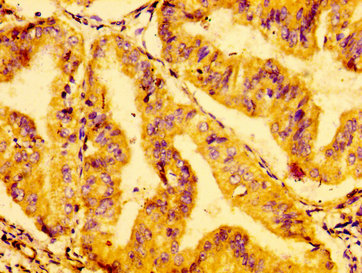GRB14 Antibody
-
货号:CSB-PA009888LA01HU
-
规格:¥440
-
促销:
-
图片:
-
IHC image of CSB-PA009888LA01HU diluted at 1:100 and staining in paraffin-embedded human cervical cancer performed on a Leica BondTM system. After dewaxing and hydration, antigen retrieval was mediated by high pressure in a citrate buffer (pH 6.0). Section was blocked with 10% normal goat serum 30min at RT. Then primary antibody (1% BSA) was incubated at 4°C overnight. The primary is detected by a biotinylated secondary antibody and visualized using an HRP conjugated SP system.
-
IHC image of CSB-PA009888LA01HU diluted at 1:100 and staining in paraffin-embedded human kidney tissue performed on a Leica BondTM system. After dewaxing and hydration, antigen retrieval was mediated by high pressure in a citrate buffer (pH 6.0). Section was blocked with 10% normal goat serum 30min at RT. Then primary antibody (1% BSA) was incubated at 4°C overnight. The primary is detected by a biotinylated secondary antibody and visualized using an HRP conjugated SP system.
-
Immunofluorescence staining of A549 cells with CSB-PA009888LA01HU at 1:100, counter-stained with DAPI. The cells were fixed in 4% formaldehyde, permeabilized using 0.2% Triton X-100 and blocked in 10% normal Goat Serum. The cells were then incubated with the antibody overnight at 4°C. The secondary antibody was Alexa Fluor 488-congugated AffiniPure Goat Anti-Rabbit IgG(H+L).
-
-
其他:
产品详情
-
产品名称:Rabbit anti-Homo sapiens (Human) GRB14 Polyclonal antibody
-
Uniprot No.:Q14449
-
基因名:GRB14
-
别名:GRB14Growth factor receptor-bound protein 14 antibody; GRB14 adapter protein antibody
-
宿主:Rabbit
-
反应种属:Human
-
免疫原:Recombinant Human Growth factor receptor-bound protein 14 protein (294-397AA)
-
免疫原种属:Homo sapiens (Human)
-
标记方式:Non-conjugated
本页面中的产品,GRB14 Antibody (CSB-PA009888LA01HU),的标记方式是Non-conjugated。对于GRB14 Antibody,我们还提供其他标记。见下表:
-
克隆类型:Polyclonal
-
抗体亚型:IgG
-
纯化方式:>95%, Protein G purified
-
浓度:It differs from different batches. Please contact us to confirm it.
-
保存缓冲液:Preservative: 0.03% Proclin 300
Constituents: 50% Glycerol, 0.01M PBS, pH 7.4 -
产品提供形式:Liquid
-
应用范围:ELISA, IHC, IF
-
推荐稀释比:
Application Recommended Dilution IHC 1:20-1:200 IF 1:50-1:200 -
Protocols:
-
储存条件:Upon receipt, store at -20°C or -80°C. Avoid repeated freeze.
-
货期:Basically, we can dispatch the products out in 1-3 working days after receiving your orders. Delivery time maybe differs from different purchasing way or location, please kindly consult your local distributors for specific delivery time.
相关产品
靶点详情
-
功能:Adapter protein which modulates coupling of cell surface receptor kinases with specific signaling pathways. Binds to, and suppresses signals from, the activated insulin receptor (INSR). Potent inhibitor of insulin-stimulated MAPK3 phosphorylation. Plays a critical role regulating PDPK1 membrane translocation in response to insulin stimulation and serves as an adapter protein to recruit PDPK1 to activated insulin receptor, thus promoting PKB/AKT1 phosphorylation and transduction of the insulin signal.
-
基因功能参考文献:
- We investigated the modification of air pollution and diabetes association by a genetic risk score covering 63 T2D genes. Five single variants near GRB14, UBE2E2, PTPRD, VPS26A and KCNQ1 showed nominally significant interactions with PM10 (P<0.05). Our results suggest that genetic risk for T2D may modify susceptibility to air pollution through alterations in insulin sensitivity. PMID: 27281273
- The N-terminus of the BPS domain plays an important role in the regulation of human Grb14 and insulin receptor complex formation through phosphorylation, in addition to other domains. PMID: 28130417
- Colorectal cancer patients with high GRB14 levels had a shorter survival and GRB14 was upregulated at an advanced clinical stage with enhanced tumor invasion and lymph node metastasis. PMID: 26965150
- Phosphorylation of Grb14 BPS domain by GSK-3 correlates with complex forming of Grb14 and insulin receptor. PMID: 24535599
- Genes within recently identified loci associated with waist-hip ratio (WHR) exhibit fat depot-specific mRNA expression, which correlates with obesity-related traits. Adipose tissue (AT) mRNA expression of 6 genes (TBX15/WARS2, STAB1, PIGC, ZNRF3, GRB14 PMID: 23670221
- Modulation of mouse rod photoreceptor responses by Grb14 protein. PMID: 24273167
- ANKRD55 rs459193 and GRB14 rs13389219 associate with insulin resistance. PMID: 23457408
- Grb14 is the first negative regulator of CEACAM3-initiated bacterial phagocytosis and might help to focus granulocyte responses to the subcellular sites of pathogen-host cell contact PMID: 22948154
- A new role for Grb14 in finely tuning receptor signaling and modulating thyroid cancer progression. PMID: 22158039
- serves as an adaptor protein to recruit 3-phosphoinositede-dependent kinase-1 to activated insulin receptor, thus promoting Akt phosphorylation and transduction of the insulin signal PMID: 15210700
- regulation of Grb14 expression levels in response to hormonal stimuli, and are consistent with its role as a repressor of insulin signaling where it is induced as a negative feedback mechanism. PMID: 15372466
- Grb14 may regulate signalling through the insulin receptor by controlling its tyrosine dephosphorylation in a site-specific manner. PMID: 16582879
- GRB14 is a weight-loss-responsive gene in skeletal muscle. Its observed transcriptional modulation may improve insulin signaling, with weight loss. PMID: 16849634
- Grb14 regulates insulin action at two levels, through insulin receptors binding and by interfering with downstream pathways. PMID: 19359342
显示更多
收起更多
-
亚细胞定位:Cytoplasm. Endosome membrane; Peripheral membrane protein.
-
蛋白家族:GRB7/10/14 family
-
组织特异性:Expressed at high levels in the liver, kidney, pancreas, testis, ovary, heart and skeletal muscle.
-
数据库链接:
HGNC: 4565
OMIM: 601524
KEGG: hsa:2888
STRING: 9606.ENSP00000263915
UniGene: Hs.411881
Most popular with customers
-
-
YWHAB Recombinant Monoclonal Antibody
Applications: ELISA, WB, IF, FC
Species Reactivity: Human, Mouse, Rat
-
Phospho-YAP1 (S127) Recombinant Monoclonal Antibody
Applications: ELISA, WB, IHC
Species Reactivity: Human
-
-
-
-
-
























